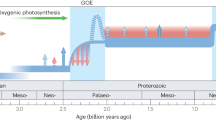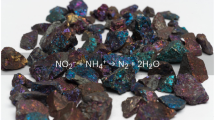Abstract
Communities of abundant organisms, similar to those which surround the hydrothermal vents of the East Pacific Rise (EPR), occur in 3,266 m of water in the Gulf of Mexico. They were discovered with the Alvin at 26° 02′ N, 84° 55′ W in an area where pore waters seep from the Cretaceous limestones of the adjacent platform at the contact between the Florida Escarpment and the Holocene hemipelagic sediments of the Abyssal Gulf. Because of the unusual abundance of organisms in this deep-sea environment, and the taxonomic similarities to the chemosynthetically based communities which surround the hydrothermal vents on the EPR, the seep communities are suspected to exist on a local non-photosynthetic food source1. We have now measured isotope ratios in tissues of organisms which surround these saline seeps to determine the origin of the local food chain. The tissues have extremely negative δ13C (−42 to −77‰, PDB) and δ15N (−2.72 to −9.34‰ air) values. Such highly fractionated carbon and nitrogen isotopes are unknown in food chains based on photosynthesis, suggesting that these communities are chemosynthetic. The cause of this extreme fractionation is attributed either to assimilation from local supplies of isotopically depleted methane and ammonium or to biochemical fractionation. The tissues of these animals contain significant amounts of 14C (∼60% modern), so the source of this fractionated carbon is not predominantly fossil methane.
This is a preview of subscription content, access via your institution
Access options
Subscribe to this journal
Receive 51 print issues and online access
$199.00 per year
only $3.90 per issue
Buy this article
- Purchase on Springer Link
- Instant access to full article PDF
Prices may be subject to local taxes which are calculated during checkout
Similar content being viewed by others
References
Paull, C. K. et al. Science 226, 965–967 (1984).
Jannasch, H. W. in Hydrothermal Processes at Seafloor Spreading Centers (eds Rona, P. A., Bostrom, K., Laubier, L. & Smith, K. L.) 677–709 (Plenum, New York, 1984).
Rau, G. H. & Hedges, J. I. Science 203, 648–649 (1979).
Williams, P. A., Smith, K. L., Druffel, E. M. & Linick, T. W. Nature 292, 448–449 (1981).
Southward, A. J. et al. Nature 293, 616–620 (1981).
DeNiro, M. J. & Epstein, S. Geochim. cosmochim. Acta 42, 495 (1978).
Deines, P. in Handbook of Environmental Geochemistry Vol.1 (eds Fritz, P. & Fontes, J. C.) 329–406 (Elsevier, Amsterdam, 1980).
Letolle, R. in Handbook of Environmental Geochemistry Vol.1 (eds Fritz, P. & Fontes, J. C.) 407–433 (Elsevier, Amsterdam, 1980).
Sweeney, R. E., Liu, K. K. & Kaplan, I. R. in Stable Isotopes in the Earth Sciences (ed. Robinson, B. W.) 9–26 (NZ Department of Scientific and Industrial Research, Wellington, 1978).
Wada, E. in Isotope Marine Chemistry (eds Goldberg, E. D., Horibe, Y. & Saruhashi) 375–398 (Uchida Rokakuho, Tokyo, 1980).
Rau, G. H. Nature 289, 484–485 (1981).
Cavanaugh, C. M., Gardiner, S., Jones, M. L., Jannasch, H. W. & Waterbury, J. B. Science 213, 340–342 (1981).
Turner, R. D. & Lutz, R. A. Oceanus 27(3), 54–62 (1984).
Frank, D. L., Gormly, J. R. & Sackett, W. M. Bull. Am. Ass. Petrol. Geol. 58, 2319–2325 (1974).
Claypool, G. E. & Kaplan, I. R. in Natural Gases in Marine Sediments (ed. Kaplan, I. R.) 99–139 (Plenum, New York, 1974).
Donahue, D. J., Jull, A. J. T., Zabel, T. H. & Damon, P. E. Nucl. Instrum. Meth. 218, 425–429 (1983).
Jull, A. J. T., Donahue, D. J. & Zabel, T. H. Nucl. Instrum. Meth. 218, 509–514 (1983).
Broecker, W. S. & Peng, T.-H. Tracers in the Sea, 306–311 (Eldigio, New York, 1982).
Milliman, J. D. Marine Carbonates, 116 (Springer, New York, 1974).
Large, P. J. Methylotrophy and Methanogenesis, Aspects of Microbiology, Vol. 8, 25–56 (American Society for Microbiology, Washington, 1984).
Williams, P. M. & Gordon, L. I. Deep-Sea Res. 17, 19–27 (1970).
Author information
Authors and Affiliations
Rights and permissions
About this article
Cite this article
Paull, C., Jull, A., Toolin, L. et al. Stable isotope evidence for chemosynthesis in an abyssal seep community. Nature 317, 709–711 (1985). https://doi.org/10.1038/317709a0
Received:
Accepted:
Issue Date:
DOI: https://doi.org/10.1038/317709a0
This article is cited by
-
Extreme longevity in a deep-sea vestimentiferan tubeworm and its implications for the evolution of life history strategies
The Science of Nature (2017)
-
Heterogeneous energetic pathways and carbon sources on deep eastern Mediterranean cold seep communities
Marine Biology (2010)
-
Extant fauna of ancient carbon
Nature (1995)
-
Consideration of the oasis analogy for chemosynthetic communities at Gulf of Mexico hydrocarbon vents
Geo-Marine Letters (1994)
Comments
By submitting a comment you agree to abide by our Terms and Community Guidelines. If you find something abusive or that does not comply with our terms or guidelines please flag it as inappropriate.



